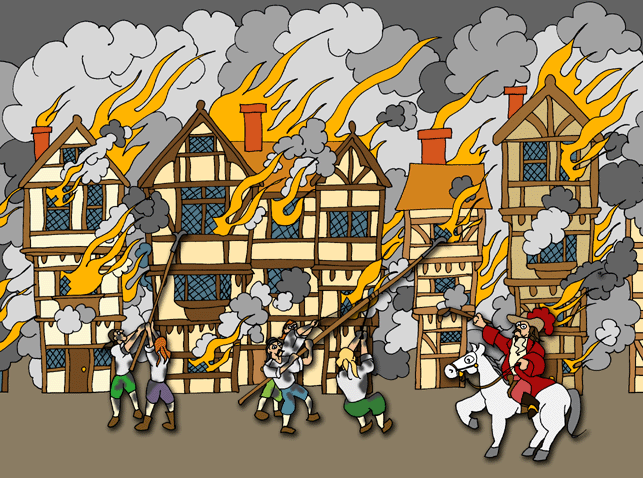|
Kids Home
London
Royalty
Romans
Early
Kingdoms
Berkshire
Teacher's Page
Mail David


|
|

and the Fire-Fighting Earl of
Craven

- In 1666, the year after the Great
Plague, a huge fire broke out in the City of London. There was
still some plague about and the fire got rid of it.
- It started in the early hours of
the morning on Sunday 2nd September, in the baker's shop of Thomas
Farriner in Pudding Lane. He hadn't put out the fire in his oven
properly.
- There was no fire brigade in
those days. The buildings were made of wood and very close together.
So the fire spread quickly across the City.
- Buckets of water, hand-squirts
(a bit like water pistols) and fire hooks (to pull burning thatch off
roofs) weren't much use.
- The best way to fight the fire
was to pull down buildings. This made firebreaks (gaps) over which the
fire could not spread.
- The Lord Mayor, Thomas
Bloodworth, was in charge of fire-fighting. He did not want to pull
down buildings because the law said he would then have to pay for
rebuilding them.
- But, late on Sunday, he was
forced to ask King Charles II for help. The King sent the Earl
of Craven to organise things. He was a fire expert:
- The Earl's hobby was
fighting fires.
- He would pay big rewards to
the first person to tell him about an outbreak of fire in London.
- He would jump on his white
horse, which he kept ready, and ride out to do what he could to
help.
- Some people said, "His
horse smelt a fire as soon as it happened."
- With a group of sailors, he
began to pull down buildings. Later, Samuel
Pepys, suggested they use
gunpowder to blow them up. He wrote about it in his famous diary.
- Eventually, the wind died away
on Wednesday 5th September. The
firebreaks started to work properly and the fire stopped.
- It had destroyed over 13,000
houses and 87 churches including St. Paul's
Cathedral. The Tower of London
and some of the houses round Bishopsgate were OK though. About 100,000
people were made homeless, but only 6 people were killed.
- People had fled the City on foot
and by boat on the River Thames to the fields around London. Some
people made it as far as Windsor.
- Later, London was rebuilt in
stone by Sir Christopher Wren.
- Activity
Sheets available.
|
|

